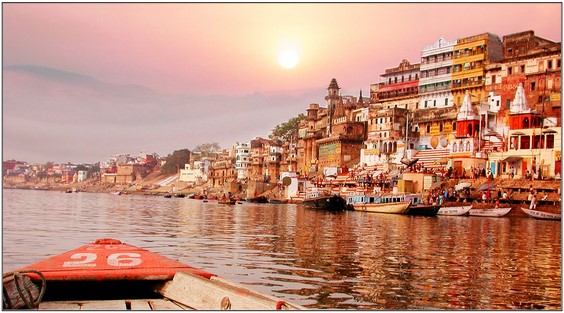The Ganga River system, also known as the Ganges River system, is a vast and complex network of water bodies that spans across multiple states in northern India and parts of Bangladesh.
The system encompasses not only the main stem of the Ganga River but also numerous tributaries, distributaries, and associated wetlands.
The Ganges River, revered as a sacred river in Hinduism, is a major river in the northern Indian subcontinent. While it is called the Ganga in India, it is internationally recognized as the Ganges. Flowing through a fertile and densely populated region, it has been of great significance throughout history. Despite its relatively short length of 1,560 miles (2,510 km), it holds immense cultural and environmental importance.
Originating in the Himalayas and eventually emptying into the Bay of Bengal, the Ganges drains a quarter of India's territory, supporting the livelihoods of millions of people. It traverses the Indo-Gangetic Plain, the heartland of Hindustan, which has been the center of various civilizations from ancient times to the Mughal Empire.
While the majority of the Ganges flows through India, its extensive delta, shared with the Brahmaputra River, is predominantly located in Bangladesh. The general direction of the river is from northwest to southeast, with its flow turning southward at the delta region.
Physiography of river Ganga
The Ganges River, also known as the Ganga, originates in the Gangotri Glacier, which is located in the state of Uttarakhand, India, in the western Himalayas. It is formed by five headstreams: the Bhagirathi, Alaknanda, Mandakini, Dhauliganga, and Pindar, all of which rise in the mountainous region of Uttarakhand state. The Alaknanda and Bhagirathi are the main headstreams, with Gangotri being a sacred place of origin for Hindu pilgrims.The river system covers a vast area, draining approximately 1,086,000 square kilometers (419,000 square miles) of land. It is one of the largest river systems in the world.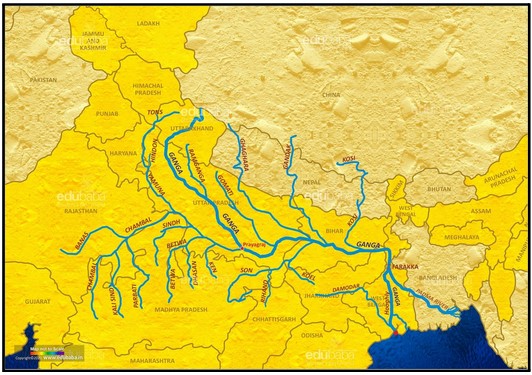
The convergence of the Alaknanda and Bhagirathi at Devprayag marks the formation of the Ganges. It flows southwestward through the Siwalik Range before emerging from the mountains at Rishikesh and reaching the plain at Haridwar, both significant Hindu pilgrimage sites.
As the Ganges progresses, it gains volume from numerous tributaries and experiences significant seasonal variations. The melting Himalayan snows contribute to its flow from April to June, while the monsoon rains from July to September cause floods. During winter, the river's flow diminishes.
In Uttar Pradesh state, the Ganges receives its major right-bank tributaries, including the Yamuna and Tons rivers. The Ramganga, Gomati, and Ghaghara rivers are prominent left-bank tributaries. In Bihar, the river is joined by the Gandak, Burhi Gandak, Ghugri, Kosi, and Son rivers. It skirts the Rajmahal Hills and reaches Farakka in West Bengal, where it forms the apex of the delta.
West Bengal is the last Indian state the Ganges passes through before entering Bangladesh. In Bangladesh, it merges with the Brahmaputra River (known as the Jamuna in Bangladesh) near Goalundo Ghat. The combined stream, called the Padma, joins with the Meghna River above Chandpur and flows into the Bay of Bengal through the extensive delta.
The Ganges-Brahmaputra system has the world's third-highest average discharge of approximately 1,086,500 cubic feet (30,770 cubic meters) per second, with the Ganges alone contributing around 390,000 cubic feet (11,000 cubic meters) per second. Its sediment load is also the highest globally, with about 1.84 billion tons per year.
The Ganges delta, stretching along the coast for about 220 miles (355 kilometers) and covering an area of approximately 23,000 square miles (60,000 square kilometers), is characterized by sediment deposits from the Ganges and Brahmaputra rivers. The region undergoes constant changes in course and is influenced by tidal processes. The Sundarbans, a vast area of mangrove forests and swamplands, lies on the seaward side of the delta and is protected as a UNESCO World Heritage site.
Throughout the delta, the rivers vary in nature, with the West Bengal rivers being sluggish while those in Bangladesh are active and interconnected by numerous creeks. The region experiences significant flooding during the monsoon season, with villages and settlements built on raised land to withstand the floodwaters.
The Panch Prayag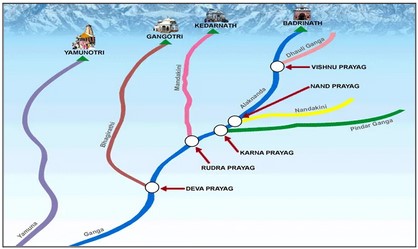
- Devprayag: Confluence of Bhagirathi river and Alaknanda river.
- Rudraprayag: Confluence of Mandakini river and Alaknanda river.
- Nandaprayag: Confluence of Nandakini river and Alaknanda river.
- Karnaprayag: Confluence of Pindar river and Alaknanda river.
- Vishnuprayag: Confluence of Dhauliganga river and Alaknanda river.
Ganga Brahmaputra Delta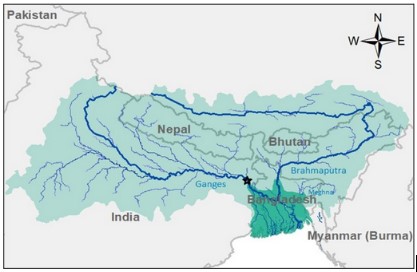
- The Ganga-Brahmaputra Delta is the largest delta in the world, located between the
Bhagirathi/Hugli and the Padma/Meghna rivers.
- It covers an area of 58,752 square kilometers.
- The coastline of the delta is highly indented, characterized by numerous inlets and
estuaries.
- The delta consists of a complex network of distributaries and islands.
- Dense forests, known as the Sundarbans, cover a significant portion of the delta.
- A major part of the delta is a low-lying swamp that experiences flooding from marine water during high tide.
Cultural and Religious Significance
The Ganga River holds immense cultural and religious significance in India. It is considered sacred and worshiped as a goddess in Hinduism. According to Hindu mythology, the river is believed to have descended from heaven to Earth to cleanse the sins of humankind.
Here are some key aspects of the socio-religious significance of the Ganga River:
- Spiritual Purification: Taking a dip in the Ganga is believed to cleanse one's sins and purify the soul. Pilgrims from all over India and even abroad visit the river to perform religious rituals and seek spiritual purification.
- Hindu Mythology and Legends: The Ganga River is deeply intertwined with Hindu mythology and legends. It is believed that the river originated from the locks of Lord Shiva, and its descent to Earth was facilitated to cleanse the ashes of ancestors and bestow salvation.
- Religious Festivals and Rituals: Various religious festivals and rituals are centered around the Ganga River. Kumbh Mela, held every 12 years, is one of the world's largest religious gatherings, where millions of devotees come together to bathe in the holy river.
- Varanasi and Haridwar: The cities of Varanasi and Haridwar, situated along the banks of the Ganga, hold immense religious significance. They are considered sacred and are popular pilgrimage destinations where devotees gather to perform rituals, offer prayers, and cremate their deceased loved ones.
- Water for Rituals and Ceremonies: The water of the Ganga is considered sacred and is used in various religious rituals and ceremonies. It is used for bathing idols, consecrating objects, and performing sacred ceremonies, symbolizing the presence of the divine.
- Environmental and Cultural Importance: The Ganga River has played a crucial role in shaping the cultural, economic, and ecological aspects of the region. It has supported agriculture, provided livelihoods to millions, and fostered diverse ecosystems along its course.
- Belief in Healing Properties: The waters of the Ganga are believed to possess healing properties. It is common for people to collect and carry the river's water back to their homes for its perceived medicinal and purifying qualities.
Overall, the Ganga River holds deep religious and cultural significance, serving as a symbol of purity, divinity, and spiritual liberation for millions of people in India.
Environmental Importance
- Biodiversity: The Ganga River basin is home to a diverse range of flora and fauna. The river supports several endangered and threatened species, including the Gangetic dolphin, Gharial crocodile, freshwater turtles, and various species of migratory birds.
- Aquatic Ecosystem: The Ganga River and its tributaries form a complex aquatic ecosystem, providing breeding grounds and habitats for numerous fish species. It is an important source of livelihood for local communities engaged in fishing and related activities.
- Water Resources: The Ganga River serves as a lifeline for millions of people residing in the Gangetic plain. It is a vital source of freshwater for irrigation, agriculture, and drinking water needs. The fertile alluvial soil deposited by the river supports agriculture and contributes to food security in the region.
- Flood Control: The vast expanse of the Ganga River basin acts as a natural floodplain, absorbing excess water during the monsoon season and mitigating the impact of floods. Wetlands associated with the river, such as the Sundarbans in Bangladesh, play a crucial role in flood control and coastal protection.
Economic significance
- Irrigation: The Ganges River has been used for irrigation for centuries. It is mentioned in ancient texts and has been developed and expanded by different rulers. Irrigation canals, both gravity-based and powered by pumps, have helped increase agricultural production, especially for cash crops like sugarcane, cotton, and oilseeds.
- Navigation: In the past, the Ganges and its tributaries served as important transportation routes. River navigation was documented as early as the 4th century BCE. Paddle steamers revolutionized inland transport in the 19th century, stimulating economic growth and trade. However, with the advent of railways and the decline of large-scale water transport, navigation on the Ganges has diminished, although it remains significant in West Bengal and Bangladesh for transporting goods.
- Hydroelectric Power: The Ganges and its tributaries have significant hydroelectric potential. India and Nepal have tapped into this potential, constructing hydroelectric power plants along various rivers. These plants generate electricity and contribute to the energy needs of the region.
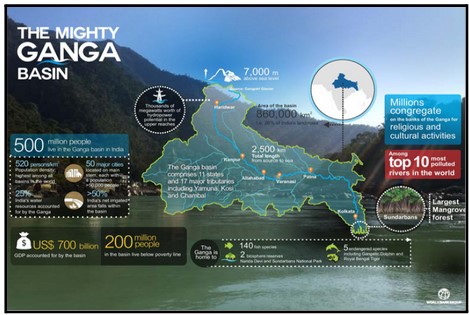
Overall, the Ganges River plays a crucial role in supporting the economy through irrigation for agriculture, transportation of goods, and the generation of hydroelectric power.
Major Projects
Multipurpose river valley projects have been implemented in India with the primary goal of fulfilling various needs such as irrigation for agriculture, electricity generation for industries, and flood control. These projects were considered crucial for the country's development, often referred to as "the temples of modern India" by J.L Nehru. The construction of dams received high priority in India's economic plans. Several significant projects, including the Tehri Project, Ramganga Project, Tanakpur Project, Gandak Project, Kosi Project, Rihand Project, Bansagar, Matatila Project, Chambal Project, Damodar Valley, and Mayurakshi Project, are associated with the Ganga River Basin. These projects play a vital role in meeting the diverse needs of the region and supporting its socio-economic development.
Environmental Challenges
- Pollution: One of the most pressing challenges facing the Ganga River system is pollution. The river receives untreated sewage, industrial waste, agricultural runoff, and religious offerings, leading to high levels of pollution and degradation of water quality. Efforts are being made to tackle this issue through pollution control measures and the promotion of sustainable practices.
- Erosion and Sedimentation: The Ganga River is known for its dynamic nature, causing erosion along its banks. This leads to land loss, displacement of communities, and changes in the river's course. Sedimentation, the process of depositing silt and sediment, also poses challenges for navigation and infrastructure development
- Water Scarcity: Increasing water demand, coupled with climate change impacts such as changing rainfall patterns and glacier retreat, raises concerns about water scarcity in the Ganga River basin. Sustainable water management practices and conservation efforts are necessary to ensure water availability for both human needs and ecological sustainability.
Conservation and Restoration Efforts:
Government Initiatives: The Indian government has launched several initiatives to conserve and restore the Ganga River. The flagship program "Namami Gange" aims to clean the river, prevent pollution, and promote sustainable use of water resources. It focuses on improving sewage treatment, solid waste management, and afforestation along the riverbanks.
The Namami Gange Yojana
The Namami Gange Yojana, also known as the Namami Ganga Project, is a comprehensive initiative by the Indian government to clean and protect the Ganga river. It aims to rejuvenate the river by integrating existing efforts and planning for future action. The project operates under the Department of Water Resources, River Development, and Ganga Rejuvenation, Ministry of Jal Shakti. It has a significant budget allocation of Rs. 20,000 crore and encompasses nearly 288 projects.
The project covers eight states, 47 towns, and 12 rivers along the Ganga. One of the key objectives is to make over 1,632 gram panchayats (village councils) on the river's banks open defecation-free by 2022. Various ministries, including Environment, Urban Development, Shipping, Tourism, and Rural Development, are collaborating with the Water Resources Ministry for the project's implementation.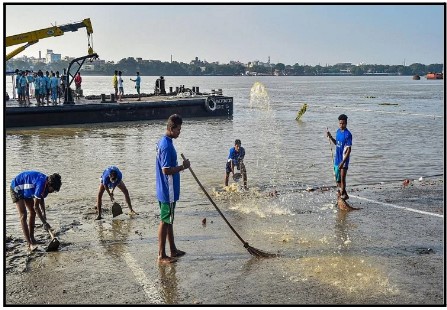
The active involvement of people living on the river's banks is a prime focus of the initiative. The National Mission for Clean Ganga (NMCG) and State Program Management Groups (SPMGs) are responsible for its implementation. The NMCG, established in 2016, replaced the National Ganga River Basin Authority (NRGBA) and serves as the implementation arm of the National Ganga Council.
The project includes measures such as river-centric urban planning, expansion of sewerage infrastructure in urban areas along the Ganga, enforcement of river regulatory zones, promotion of sustainable agricultural practices and efficient irrigation methods, establishment of a Ganga Knowledge Centre, and the introduction of the Ganga Eco-Task Force comprising four battalions of the Territorial Army.
To address pollution, the project focuses on treating wastewater through various methods such as bio-remediation, in-situ treatment, innovative technologies, and municipal sewage and effluent treatment plants. Immediate measures are also being taken to control the inflow of sewage, and a public-private partnership approach is being adopted for pollution control. The project aims to achieve a significant reduction in pollution and restore the ecological health of the Ganga river.
Other major Initiatives
Here are some other initiatives taken to address the issues related to the Ganga river:
- Ganga Action Plan: The Ministry of Environment, Forest and Climate Change initiated the Ganga Action Plan in 1985. It aimed to improve the water quality by intercepting, diverting, and treating domestic sewage.
- National River Conservation Plan: This plan is an extension of the Ganga Action Plan and focuses on cleaning the Ganga river under Phase 2 of the action plan.
- National Ganga River Basin Authority (NRGBA): The NRGBA was established by the Government of India in 2009 under the Environment Protection Act, 1986. It declared the Ganga as the national river of India and oversees the conservation and management of the river.
- Clean Ganga Fund: Formed in 2014, the Clean Ganga Fund aims to facilitate the cleaning of the Ganga river, establishment of waste treatment plants, and conservation of the river's biodiversity.
- Bhuvan-Ganga Web App: This web application encourages public participation in monitoring the pollution entering the Ganga river. It allows the public to report pollution incidents and monitor the progress of various cleaning projects.
- Ban on Waste Disposal: In 2017, the National Green Tribunal imposed a ban on the disposal of any waste into the Ganga river. This measure aims to prevent further pollution of the river.
These initiatives reflect the government's commitment to address the pollution and conservation challenges faced by the Ganga river and ensure its long-term sustainability.
Way ahead
Addressing the challenges faced by the Ganga River requires a solution-oriented approach that focuses on awareness, community participation, and international collaboration. Creating awareness about the river's significance and engaging local communities in conservation efforts is essential for fostering a sense of responsibility and ownership among stakeholders. This can be achieved through initiatives such as clean-up drives, tree plantation programs, and educational campaigns.
Furthermore, international collaboration plays a crucial role in supporting the conservation and sustainable management of the Ganga River. Collaboration with international organizations, research institutions, and funding agencies can provide technical expertise, research collaborations, and financial resources to implement effective conservation measures.
Conclusion
Preserving the ecological integrity of the Ganga River system is crucial for the well-being of both human communities and the diverse ecosystems that rely on its resources. By addressing pollution, promoting sustainable practices, and involving local communities, the Ganga River can continue to be a symbol of cultural heritage, a lifeline for millions, and a thriving ecosystem for generations to come.

